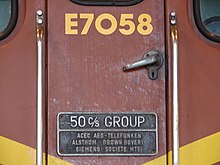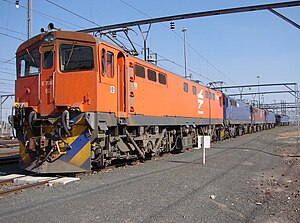SAR class 7E
| SAR class 7E | |
|---|---|
|
E7067 in orange Spoornet paint
in Beaufort West on August 2nd 2007 |
|
| Numbering: | E7001-E7100 |
| Number: | 100 |
| Manufacturer: | 50 Hz working group , UCW |
| Year of construction (s): | 1978-1979 |
| Axis formula : | Co'Co ' |
| Gauge : | 1067 mm ( cape track ) |
| Length over coupling: | 18,400 mm |
| Height: | 4,200 mm |
| Width: | 3,924 mm |
| Trunnion Distance: | 10,200 mm |
| Bogie axle base: | 4,100 mm |
| Total wheelbase: | 13.8 m |
| Service mass: | 123.5 t |
| Wheel set mass : | 21.0 t |
| Hourly output : | 3,240 kW |
| Continuous output : | 3,000 kW |
| Starting tractive effort: | 450 kN |
| Hourly traction: | 319 kN |
| Continuous tensile force: | 300 kN |
| Braking force: | 210 kN |
| Driving wheel diameter: | 1220 mm |
| Power system : | 25 kV 50 Hz alternating current |
| Number of traction motors: | 6th |
| Drive: | Paw camp |
| Brake: | Compressed air brake , vacuum brake , resistance brake |
| Coupling type: | AAR coupling |
The class 7E is the first series of electric locomotives used by the South African Railways for operation with 25 kV 50 Hz AC were procured. The six-axle locomotives with the Co'Co ' axle formula were put into service between 1978 and 1979. A total of 100 locomotives were built. The first series of 7E locomotives was followed by several replica series and conversions, some of which differ considerably from the locomotives that were initially delivered.
Manufacturer

The design of the locomotives came from the 50 Hz consortium and were built by Union Carriage & Wagon (UCW) in Nigel . UCW was also the sub-supplier for the mechanical components.
The 50 Hz working group consisted of the following European manufacturers:
- Ateliers de Constructions Electriques de Charleroi (ACEC), Belgium
- AEG-Telefunken , Germany
- Siemens , Germany
- Alsthom-Atlantique , France
- Matériel de traction électrique (MTE), France
- Brown, Boveri & Cie. , Switzerland
The locomotives were given vehicle numbers E7001 to E7100. It was the first series in which the class designation became part of the vehicle number. The previous classes 1E to 6E received consecutive numbers from E1 to E2185, with twelve numbers being omitted. The locomotives of both manufacturers were not given a serial number.
technology
The locomotive has two driver's cabs . At end 2 there is a roof ladder next to the entrance door to the driver's cab. Typical of the 7E, such as eyebrows acting gutters on the front windows were installed after the delivery.
Traction equipment
The phase angle control in thyristor technology allows infinitely variable tension and braking force control. In order to obtain the best possible power factor , it was designed as a sector control .
Deep linkage
The low linkage arranged on the outside of the bogies was previously tested on the 6E1 series and adopted by this. Together with the electronic anti-skid and traction redistribution of up to 15% between the bogies, the colloquially as allowed Grasshopper Legs " locusts legs" indicated Tiefanlenkung a maximum tensile force transmission on the rails without by turning the wheels.
Pantograph
The 7E series was the first SAR electric locomotive in which the pantographs were arranged so that the pallet was exactly above the pivot point of the bogies. This reduces the risk of the pantograph getting caught in the contact line. This is particularly great in tunnels and narrow bends as well as with switches, because at these points the pantograph moves laterally in relation to the contact line.
commitment
The 7E locomotives were primarily intended for freight traffic on the routes operated with 25 kV 50 Hz alternating current. Until 1978, only 3 kV direct current was used for the electrical operation of the main lines in South Africa , after which all new projects were carried out in 25 kV alternating current. The only exception is the Sishen – Saldanha railway line spanned with 50 kV 50 Hz alternating current . There are four separate 25 kV AC rail networks in South Africa:
- Pyramid South ( Pretoria ) - Pietersburg and Pyramid South - Brits - Rustenburg - Thabazimbi .
- Ermelo - Richards Bay ( Richards Bay Coal Line )
- Port Elizabeth - De Aar and Kimberley -De Aar Beaufort West
- East London - Springfontein .
When the Kimberley – De Aar line was electrified, it was dismantled to single-track operation with long overtaking routes and provided with Centralized Traffic Control (CTC). On this route, the 7E locomotives replaced the last large steam locomotives in South Africa, the 25NC series . The second, non-electrified track was disconnected from the network but not dismantled. In anticipation of increased traffic in connection with the manganese ore mining in Hotazel , electrification of the second track began in July 2008.
The class 7E locomotives were originally in service on the Richards Bay Coal Line. After further series of 25 kV locomotives had been delivered, some 7E locomotives were used on the lines from Pyramid South and East London, but most of them ended up in Kimberley, where they were used by freight and passenger trains to Port Elizabeth and Beaufort West were used.
Stamp
A stamp with a value of 30 cents issued on February 15, 1990 shows two class 7E locomotives with an ore train. The brand was part of a series of commemorative stamps with the theme of independence and regional cooperation in South Africa . The 7E mark was supposed to represent the integral railway network that stretches from Cape Town to Dar es Salaam in Tanzania . The stamp design was created by the stamp designer and artist H. Barrett.
painting
In the SAR locomotives carrying a golf uniform red paint with yellow bands on the side walls that ran on the front side down and thereby the vehicles a to a face whiskers (English: Whiskers ) gave reminiscent appearance. All E7 locomotives were delivered in this paint scheme. This paint was replaced by an orange, later brown paint at Spoornet. Many electric locomotives and some diesel locomotives were painted in a blue base color for use in front of the Blue Train , but without the other design elements of the paintwork having been changed. The blue locomotives thus wore the yellow whiskers in the SAR era, just like they later wore the Spoornet logo and the SPOORNET lettering , only with the brown Spoornet paint the lettering disappeared. Later, when Spoornet generally switched to a blue paint job, the locomotives for the Blue Train no longer had a special paint job. In the 7E series, the numbers 7004 to 7009 had the Blue Train paint for use on the Kimberley – Beaufort West section. Under PRASA , the locomotives used in front of passenger trains were painted purple.
Pictures of the painting variants
The picture in the info box of the article shows the number E7067 in the orange Spoornet paint. Below are some pictures of the other paints used on the 7E.
E7008 in the special blue paint of the SAR for use in front of the Blue Train, but in front of a freight train at Die Put, about 16 km south of De Aar , on May 2, 1985
E7061 in brown Spoornet paint in Beaufort West on September 16, 2009
E7010 in the Shosholoza Meyl paint from PRASA at the Edwin Swales depot in Durban on June 4, 2010
7E family
The first series of 7E was so successful that a total of 300 locomotives were reordered in several series and these were later improved through modifications. In addition to the locomotives designed by the 50 Hz consortium, orders were also made for locomotives with electrical equipment from Hitachi , for which Dorbyl, today's DCD , provided the mechanical part. Use as opposed to the group control of European locomotives switchable reactive power -Kompensations capacitors to improve the power factor . The first series of Japanese locomotives, the 7E1 , was intended for permanent use in multiple traction on the Richards Bay Coal Line, which is why they only received one driver's cab; all other series had two driver's cabs except for the locomotives from the 7E3 series, which were made by Transwerk were converted to 7E4. The series 7E2 and 7E3 had compared to the first series bogies with a shortened wheelbase to the wheel flange - and track wear reducing.
The following is an overview of the entire 7E family:
Originally delivered locomotives
| designation | numbering | features | number | Construction year | Manufacturer | image |
|---|---|---|---|---|---|---|
| 7E | E7001-E7100 | first European variant | 100 | 1978-1979 | 50 Hz working group UCW |

|
| 7E1 | E7101-E7150 | first Japanese variant only a driver's cab |
50 | 1979-1981 |
Hitachi Dorbyl |

|
| 7E2 (1st series) | E7151-E7175 | Bogies with a shortened wheelbase | 25th | 1982 | 50 Hz working group UCW |

|
| 7E2 (2nd series) | E7176-E7215 | Bogies with a shortened wheelbase, modified ventilation grilles |
40 | 1983 | 50 Hz working group UCW |

|
| 7E3 (1st series) | E7216-E7275 | Bogies with a shortened wheelbase | 60 | 1983-1984 |
Hitachi Dorbyl |

|
| 7E3 (2nd series) | E7277-E7300 | Bogies with a shortened wheelbase | 25th | 1984-1985 |
Hitachi Dorbyl |

|
Conversions
| designation | numbering | features | number | Construction year | Manufacturer | image |
|---|---|---|---|---|---|---|
| 7E4 | E7260-E7276 | only one driver's cab converted from 7E3 |
17th | 2000-2003 | rebuilt by Transwerk |

|
| 7E5 | E7286 – E7300 and others |
rebuilt from 7E3 later rebuilt to 7E6 |
more than 15 | after 2003 | rebuilt by Transwerk |

|
|
7E6 later referred to as 7E3 |
E7216-E7259 E7277-E7300 |
first converted from the 7E3 locomotives that were not converted to 7E4 or 7E5, later from all 7E5 | 58 | after 2003 | rebuilt by Transwerk |

|
Web links
Individual evidence
- ↑ a b c d e f Leith Paxton and David Bourne: Locomotives of the South African Railways . C. Struik, Cape Town 1985, ISBN 978-0-86977-211-9 .
- ^ UCW - Electric locomotives . The UCW Partnership. Archived from the original on October 12, 2007. Retrieved September 30, 2010.
- ↑ a b c d e South African Railways Index and Diagrams Electric and Diesel Locomotives, 610 mm and 1065 mm Gauges, Ref LXD 14/1/100/20, January 28, 1975, with appendices
- ^ A b c John N. Middleton: Railways of Southern Africa Locomotive Guide - 2002 . Beyer-Garratt Publications, Herts, UK 2002.
- ^ Railways Africa, 5 Aug 2007: Kimberley-De Aar Electrification
- ^ Philatelic Bulletin 207, published by Philatelic Services and INTERSAPA, 1990
- ↑ E1973 in blue based on orange livery
- ↑ E1951 in blue based on maroon livery








